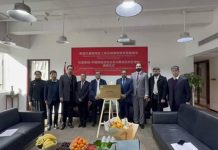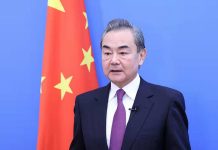
In February, U.S. Congress introduced 10 acts to restrain China’s development, and raised extensive concerns domestically and internationally. Much of the acts’ content is a mere restatement of earlier acts, with limited substantive impact on China. It’s important to avoid falling into the trap of the U.S. discourse while making clear China’s own priorities and addressing risks and challenges.
Acts targeting China
In February, at a hearing held by the U.S. House Financial Services Committee on combating the “economic threat” from China, these acts were proposed and discussed before being passed roughly a month later. The move appears to have been carried out hastily while indicating a sense of intentional planning.
The 10 acts, related to finance, the Taiwan region and public health, mainly fall on the four domains.
First, there’s an attempt to suppress the status of China’s currency renminbi, or the yuan. This includes the “Chinese Currency Accountability Act” and the “China Exchange Rate Transparency Act,” involving moves pressuring U.S. officials at the International Monetary Fund (IMF) to prevent an increase in the yuan’s share in the Special Drawing Rights (SDR) basket, as well as demanding greater transparency in China’s exchange rate system.
Second, there are efforts to curb China’s rising international financial influence. The “China Financial Threat Mitigation Act” and the “Aligning SEC Regulations for the World Bank’s International Development Association Act” request U.S. financial regulatory agencies to submit reports on U.S. exposure to financial risks from China. The acts also attempt to boost U.S. influence within the World Bank’s International Development Association.
Third, the superpower attempts to interfere in China’s Taiwan region with the “Taiwan Conflict Deterrence Act,” the “Taiwan Non-Discrimination Act,” and the “PROTECT Taiwan Act.” They restrict financial services for Chinese government personnel and their families, back the Taiwan authorities’ engagement in IMF activities, and obstruct China’s participation in the Group of 20 (G20) and the Bank for International Settlements.
Last, the “Preventing the Financing of Illegal Synthetic Drugs Act,” the “Securing America’s Vaccines for Emergencies Act,” and the “Public Health Emergency Medical Supplies Enhancement Act” attempt to boost U.S. influence and diversify vaccine supply chains.
On May 22, the House passed the “China Financial Threat Mitigation Act” and the “Preventing the Financing of Illegal Synthetic Drugs Act.” The remaining eight acts have only been reviewed by the Financial Services Committee. They still need to go through the House and Senate voting before being officially signed into law by the president. Each of the steps carries uncertainties. Previously, a number of acts, despite being reviewed by special committees and having passed the House of Representatives vote, ultimately did not become effective. They were more about political posturing than actual implementation.
Limited impact
Five out of the 10 acts are repetitions of proposals that have been made before. Now, they have been reintroduced, with their primary content largely unchanged from before. Additionally, the punitive actions have not gone beyond the conventional scope of the financial sanctions toolbox utilized by the U.S. against foreign entities.
The “China Financial Threat Mitigation Act” and “China Currency Accountability Act” have come too late to curb China. They were initially proposed in May and June 2021, respectively. The former aimed to suppress the increase of the yuan’s weight in the SDR basket currency adjustment by the end of July 2022, while the latter imposes financial containment measures under the pretext of reducing financial risks from China’s real estate market. However, in the latest SDR valuation review by the IMF in May 2022, the yuan’s weight in the SDR basket of currencies increased from 10.92 percent to 12.28 percent. Add to that the fact China has optimized real estate financing policies, improving the financing environment for quality real estate companies. Market transactions have increased, resulting in the restoring of market confidence.
The “Preventing the Financing of Synthetic Drugs Act” and two other acts involve the U.S. enhancing its influence in international organizations and cooperation, as well as increasing the independence of drug supply chains. These measures have a limited impact on China.
Prioritizing own affairs
China’s large economic size, growth potential and strong resilience empower it to resolve financial risks and uphold financial security as it pursues development.
China needs to deepen the structural reform of the financial supply side, fine-tune the overarching framework of the financial system, and establish a comprehensive mechanism. This includes increasing resources for managing risks, diversifying protective measures, strengthening regulatory coordination, and improving the effectiveness of financial oversight. By more accurately and effectively addressing risks in key areas, mitigating risks in cross-sector financial businesses, and preventing emerging risks, China can counteract the harmful hype created by external forces seeking to undermine China’s progress.
China needs to further advance financial opening up to enhance international competitiveness. It should create a top-notch business environment that is market-oriented, based on the rule of law, and globally integrated. This entails progressively removing restrictions on financial transactions and products, as well as various barriers to entering the domestic financial market. China should steadily extend structured openness in financial rules, regulations, management, standards and more. It is imperative to enhance the country’s global standing in terms of financial accessibility, continuously increase the appeal and capacity of the domestic market for international investment, and amplify the international influence of the domestic financial market.
China should strengthen regional financial cooperation and mitigate the potential impact of U.S. sanctions. It should expand financial cooperation with East Asian countries, ASEAN and the European Union, and increase the proportion of local currency settlements in bilateral trade. In regional economic cooperation negotiations, China needs to facilitate a new international financial governance system that better suits the interests of emerging market countries. It needs to deepen financial cooperation with countries along the route of the Belt and Road Initiative, a China-proposed plan that aims to boost connectivity along and beyond the ancient Silk Road routes, strengthen the role of regional and international financial institutions such as the Silk Road Fund and the Asian Infrastructure Investment Bank, improve existing currency stability mechanisms like the Chiang Mai Initiative and the BRICS Contingent Reserve Arrangement, and engage in financial collaboration with international partners such as Islamic countries and the Franc Zone of the African Financial Community.
It is important to systematically promote the global adoption of the yuan, and expand its role as an international currency for trade settlement, investment and financing. China need to fine-tune the policy structure for the yuan’s international use, bolster its internationalization infrastructure such as account systems and payment clearing mechanisms, guide financial institutions in improving their cross-border yuan financial service capabilities, and better meet the settlement requirements of Belt and Road and ASEAN countries. China should holistically unlock its financial markets through institutional measures, establish a more welcoming and accessible investment environment, and boost foreign entities’ inclination to hold the yuan.
Finally, China needs to further elevate its status and role in the international financial governance system by pushing for reforms in the IMF and World Bank, striving for more voting rights and influence, and increasing the weight of the yuan in the SDR basket. It must also push for the diversification of the sources of employees and executives in international financial organizations. China should continue to make good use of international cooperation platforms such as the G20 to enhance institutional arrangements and mechanisms for coordinating international macroeconomic policies. It also needs to expand and participate in international cooperation in green finance, and expand international influence under multilateral platforms such as the International Platform on Sustainable Finance and the Central Banks and Supervisors Network for Greening the Financial System. –The Daily Mail-Beijing Review news exchange item



